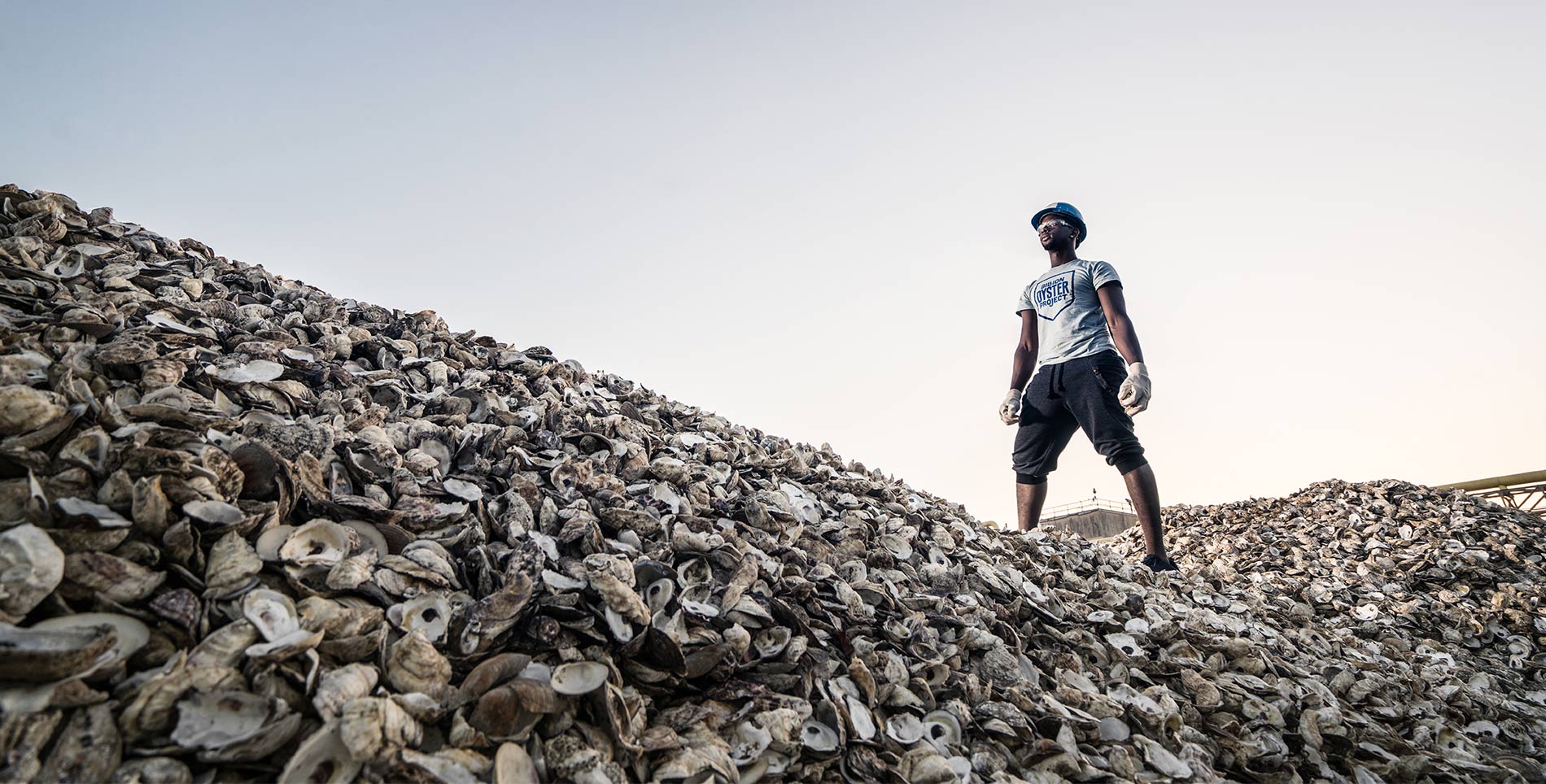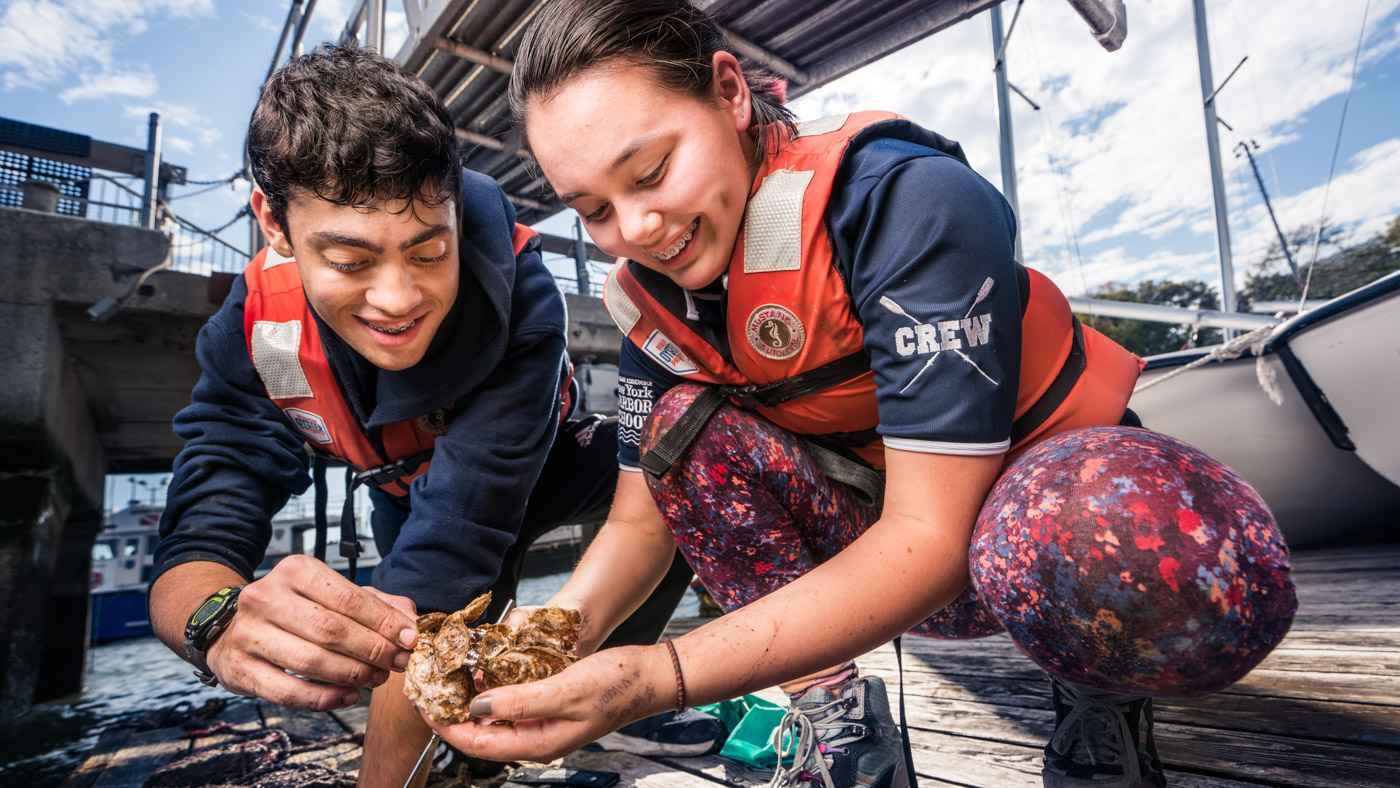April 10, 2020 — The Extinction Issue
Billion Oyster Project Builds on Centuries of New York History
Heroes in a Half Shell

Words by Stef Ferrari
Photography by Benjamin Von Wong

This story can also be found in The Extinction Issue of Life & Thyme Post, our limited edition printed newspaper for Life & Thyme members.
In addition to more than twenty-six thousand restaurants across five boroughs, there are twelve thousand some odd street vendors in New York City. To hungry visitors and city dwellers alike, they sell hot dogs and pretzels, roasted pecans and coffee, skewers and kebabs of all kinds, soft serve ice cream cones, and so much more. So much, in fact, that the identity of the city is tied up in these treats. But as iconic as these foods have come to be, none can lay claim to being as foundational as the New York oyster.
New York may rely on the industry these vendors bring to the table today, but in centuries past, the city was quite literally built on oysters. Pearl Street is not only named for the treasure sometimes trapped inside the bivalve, but it was paved with its shells. Oysters were so prevalent in the 1600s when Dutch settlers first landed on the island that their shells were ground into mortar and used in construction. “It’s estimated that half the world’s oyster population was in and around the New York Harbor at that period in time, which is just incredible—220,000 acres covered with oysters,” says Helene Hetrick, communications manager for Billion Oyster Project
Beyond their importance to the infrastructure, they were hugely significant to the health of early New York area dwellers, dating back to the indigenous Lenape who lived on a diet in which bivalves featured heavily. In the 1800s, the city devoured an estimated one million oysters per day. They were found on menus in most high-end spots, but were also sold from corner carts not unlike the ones of today’s street vendors, making oysters a societal equalizer. “It was food that every social class consumed—the richest of rich, the poorest of poor could go down to the harbor and pick out oysters from the harbor and eat them,” Hetrick says.
But in time, their popularity became problematic for the oyster population. “Overharvesting is a huge contributor because they started to send those oysters elsewhere,” Hetrick says. Challenges were compounded by the influx of industry in the eighteenth and nineteenth centuries to New York, which she notes contributed to significant levels of pollution. “Quickly, the oysters were being removed and pollution was being put in,” she says. Faced with a polluted harbor, “You had pretty much as close to a dead water body as you can get.”

“It was food that every social class consumed—the richest of rich, the poorest of poor could go down to the harbor and pick out oysters from the harbor and eat them.”
This left the harbor depleted and inhospitable for much of the twentieth century. In 1972, however, the Clean Water Act was implemented with the goal of helping mitigate pollution by regulating quality standards under the Environmental Protection Agency. “[The act] was incredibly helpful in stopping some of that pollution from being dumped in the harbor, and ever since then we’ve made huge strides in cleaning up that water,” Hetrick says. However, she continues, “we’re still polluting the harbor, and not viewing it as the great resource it is.”
Recognizing and realizing the potential of the harbor is where Billion Oyster Project, the organization with whom Hetrick works, steps in. Founded in 2014 by Murray Fisher and Pete Malinowski, BOP expresses a goal of restoring one billion live oysters to New York Harbor by 2035. The operation believes education is a major component of achieving that goal, and according to their website also offers “public school students, volunteers, community scientists and restaurants the opportunity to learn about New York City’s rich oyster history and lead the movement to restore it.”
Hetrick explains the motivation for singling out oysters is threefold. First, she says, they possess an inherent superpower making them ideally equipped to help improve overall water quality; a single oyster has the ability to filter fifty gallons of water per day.
Secondly, BOP refers to oysters as “ecosystem engineers,” and in speaking with Hetrick, it’s easy to understand why. “They’re great at creating a habitat for all different kinds of marine wildlife, everything from little arthropods that are cleaning our water at the bottom of our harbor, up to the whales and seals and larger mammals,” she says.
Lastly, and according to Hetrick, “increasingly important, is their ability to soften the blow of large waves and flooding that is becoming more prevalent with climate change.”
BOP’s work in supporting these extraordinary creatures is multidisciplinary, and ranges from restoring oyster reefs, to STEM (Science, Technology, Engineering and Mathematics) programs in which students from more than one hundred New York schools participate, to CTE (Career and Technical Education) options for students hoping to pursue careers in the maritime space.
Additionally, the organization operates a shell collection program, which engages more than seventy-five restaurants across Manhattan and Brooklyn. While oysters once found reincarnation as a part of dry-land infrastructure, Hetrick explains the ways in which spent oyster shells can be reused in the harbor to perpetuate their own growth. “Oysters need a hard substrate to attach to in order to grow,” she says. Used oyster shells, she says, tend to be rich in calcium carbonate, making them an ideal solution.

And BOP has found a reliable source in the city’s restaurant scene. “We collect oyster and clam shells from seventy-five restaurants from across Brooklyn and Manhattan, and we let them cure for one year,” Hetrick says. During the process, shells are cleaned and pathogens removed, making them a welcome foundation for new oysters. From there, “On our site on Governors Island we have a hatchery, and we’re able to actually spawn those oysters and put them into a tank with those recycled shells. It’s amazing; within a couple weeks they attach to those shells and begin their own process of growing and making new reefs, which we’ll then put into the water.”
BOP has made significant progress toward its goal. “To date, we’ve put in more than thirty million oysters into the harbor across thirteen different reef sites, which are essentially spread across the five boroughs,” Hetrick tells me. Data is collected periodically throughout the year in accordance with water quality and currents. And another result has been the recruitment of wild oysters. “We’ve seen wild oysters attach themselves to some blank shell we put into the harbor, and that’s probably even more exciting than seeing the growth of our hatchery oysters because it shows our goal of restoring New York Harbor is possible,” she says. “There’s still wild larvae swimming around looking for a spot to land.”
The work is achieved with the help of dedicated volunteers, the number of which in the course of five years has totaled over ten thousand. “We absolutely could not get these oysters in place without the volunteers,” Hetrick says. She describes the sessions, which include rinsing and bagging shells, and are attended by individuals as well as corporate groups. “On top of doing something great for our local environment, they’re coming together and working toward a goal. People feeling like they’ve had a hand in the process is really important,” she continues. “It seems to make a difference in having people come back and see how the process is progressing.”
Beyond hands-on efforts, the average diner has their own delicious way to support BOP: eat more oysters. “We actually find that oysters and shellfish are one of the more sustainable seafoods to be consuming, and are one of the more sustainable foods in general. The way they grow, they can be quite plentiful,” Hetrick says.
From what he’s seen in his restaurants, Chef Kerry Heffernan says encouraging more folks to enjoy oysters shouldn’t be a problem. American consumption is up according to the Food and Agriculture Organization of the United Nations, which cites some domestic efforts like the Maine oyster industry experiencing “massive expansion,” and consumer awareness having exploded. “In the last ten years, the interest in oysters and the understanding from a consumer level of the variety and nuances has grown by leaps and bounds,” he says. “You have a subculture of diners that know a lot more about oysters than I do because it’s their passion and hobby and they’re going everywhere and trying everything and giving you all sorts of critiques and nuances.”
Heffernan has been working with BOP for five years, and recognizes the program’s success has been no easy feat. “It’s so complex, scientific, interesting and challenging what they’re up against, not just once they grow the oysters to a stage at which they can attach themselves,” he says. “But even getting to that stage, there are so many tiny factors that can mess that up.”
Heffernan describes the Hudson to me as “not the most life-giving of rivers.” With that in mind, he is especially encouraged by what BOP has been able to coax from its waters, saying, “Here, we see firsthand the phenomenal health of these animals and how quickly they grow, and how little mortality there is.”
Heffernan also has seen the organization’s impact in New York City communities. Heffernan’s restaurant on Governors Island, Island Oyster, is neighboring the BOP facility. “I’ve had a chance to visit more than once. We see the kids and we’re trying to train their kids to be shuckers and branch that relationship into other areas. They bring that science firsthand to so many people,” he says. “It’s great that you have this audience of interest and they have friends who they influence. It continues to grow layers of curiosity.”
That curiosity helps BOP continue with that core component of their mission. “Equally important is the process of educating New Yorkers about their environment. We feel like we could restore these oysters and probably do it quicker than we are now, but we feel it’d be meaningless without a next generation that can help sustain this work later on,” Hetrick says. “We always love to get that point across because the restoration and the education are really intertwined, and what will make this successful in the long run.”
They may no longer pave the city streets, but if happy-hour ads and brunch special sandwich boards through the five boroughs are any indication, New York City’s oyster legacy shows no signs of dying out.






Our comments section is for members only.
Join today to gain exclusive access.